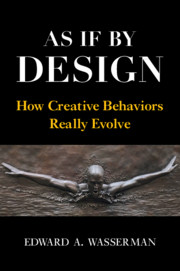Book contents
- As If By Design
- As If By Design
- Copyright page
- Dedication
- Contents
- Figures
- Acknowledgments
- Section 1 Introduction
- Section 2 The Vignettes
- Part I Sports
- Part II Medicine
- 6 The Apgar Score
- 7 The Ponseti Method
- 8 The Heimlich Maneuver
- 9 Eating to Live
- 10 What’s in a (Drug) Name?
- 11 Self-Medication by People and Animals
- 12 Personalized Medicine
- Part III Hygiene
- Part IV Arts, Entertainment, and Culture
- Part V Is This Heaven? No, It’s Iowa!
- Section 3 Putting It Together
- Index
- References
11 - Self-Medication by People and Animals
from Part II - Medicine
Published online by Cambridge University Press: 01 July 2021
- As If By Design
- As If By Design
- Copyright page
- Dedication
- Contents
- Figures
- Acknowledgments
- Section 1 Introduction
- Section 2 The Vignettes
- Part I Sports
- Part II Medicine
- 6 The Apgar Score
- 7 The Ponseti Method
- 8 The Heimlich Maneuver
- 9 Eating to Live
- 10 What’s in a (Drug) Name?
- 11 Self-Medication by People and Animals
- 12 Personalized Medicine
- Part III Hygiene
- Part IV Arts, Entertainment, and Culture
- Part V Is This Heaven? No, It’s Iowa!
- Section 3 Putting It Together
- Index
- References
Summary
Modern medicine is constantly making progress to prevent and cure a wealth of serious maladies. Drugs are a key weapon in medicine’s armament. Today, novel pharmaceuticals are marketed at an ever-increasing rate. As new drugs are approved for dispensing to the public, fresh brand names must be contrived for each. This task is both challenging and intricate, often leading to exotic and tongue-twisting monikers like Biktarvy (for HIV), Erleada (for prostate cancer), Ilumya (for plaque psoriasis), Lucemyra (for opioid withdrawal), Aimovig (for migraine), Olumiant (for rheumatoid arthritis), Seysara (for severe acne), and Aemcolo (for diarrhea). What accounts for such weird names? How are those names generated? How are they chosen? How are they approved? It turns out that a strikingly Darwinian process is at work in drug naming, one which is a lucrative business and adds considerable cost to the price of prescription medications.
Keywords
- Type
- Chapter
- Information
- As If By DesignHow Creative Behaviors Really Evolve, pp. 112 - 120Publisher: Cambridge University PressPrint publication year: 2021



